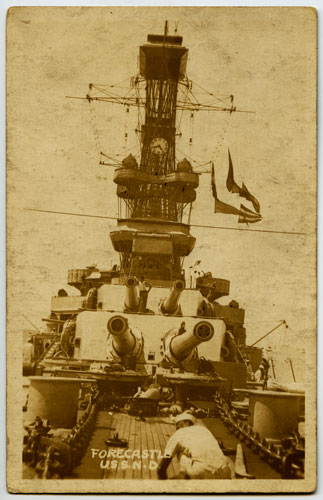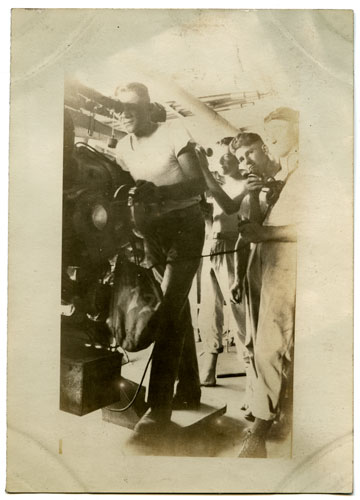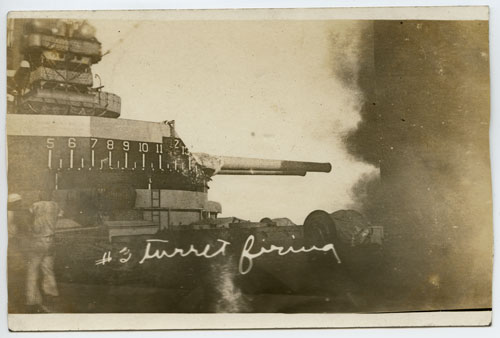Introduction | Work | Education | Athletics | Social Events | Fire & Engine Trouble |
Gunnery Practice | Activities

On October 31, 1910 shortly after recovering from the first fire, the USS North Dakota entered gunnery competition where she placed 6th out of 16 ships in firing at targets between 6500 and 10,000 yards distant. The winner that year, was North Dakota’s sister ship, the USS Delaware.
Over the next few years, the men of the North Dakota practiced loading, firing, and hitting the targets. Once considered drudgery, in the modern Navy gunnery practice was considered to be “the greatest game in the world” according to one officer. The excitement and sense of competition was shared by the enlisted men and the officers.
The battleships practiced firing on partially sunken vessels and on canvas targets. Some practice was at long range (11,000 yards or 6.25 miles) and some at close range of 2500 to 3000 yards (between 1 and 2 miles).
When one loading crew practiced, they were timed by the officer in charge of the gun. The first test with dummy ammunition took 15 seconds; the officer declared the effort “rotten.” They practiced again, reducing the time to 12 seconds. It was still not good enough. The third effort resulted in a time of 10 seconds. The officer praised the men, saying “Bully, lads – that will do.”

Gunnery practice took place at night and in the daytime. On one occasion during night practice, the ship was shooting at canvas targets. The targets were retrieved and laid on the deck so the holes could be counted. Even the enlisted men who were not assigned to gun duty stayed up late to learn the results. Officers watched, too. To the great “enthusiasm of the ships’ company,” the North Dakota had hit 98 out of 120 rounds, good enough to beat the Delaware’s score of the previous night.
Practice and refinement of the skills of loading, sitting, and firing the guns proved that the North Dakota’s big guns could fire 3 rounds per minute. Altogether, her ten 12-inch guns could fire thirty rounds per minute.
By 1915, the North Dakota could compete well in the fleet’s gunnery practice. During gunnery practice in January that year, the North Dakota hit 60.518 per cent of her shots – a grand improvement over the thirty percent originally expected of the this type of ship, and a massive improvement over the two to threes per cent success rate of the Navy in the Spanish American War.

Practice on the big guns of the dreadnoughts such as the North Dakota brought about a spirit of teamwork in the floating community. One reporter who was present when the big guns were fired wrote:
There is a community of interest between the officers and men. The reasons for every order are fully explained, so that the men are thoroughly familiar with the object sought and with the material used. This applies not only to loading and firing the guns but to the whole fire-control and range-finding system, so that when a naval battle is fought, intelligent petty officers may take the place of officers who are killed or disabled. The whole service is working together with one end in view, that of efficiency in battles.
Sources: Scientific American, 11 November and 9 December, 191; New York Times, 31 October 1910, 17 January 1915
Address:
612 East Boulevard Ave.
Bismarck, North Dakota 58505
Get Directions
Hours:
State Museum and Store: 8 a.m. - 5 p.m. M-F; Sat. & Sun. 10 a.m. - 5 p.m.
We are closed New Year's Day, Easter, Thanksgiving Day, Christmas Eve, and Christmas Day.
State Archives: 8 a.m. - 4:30 p.m. M-F, except state holidays; 2nd Sat. of each month, 10 a.m. - 4:30 p.m. Appointments are recommended. To schedule an appointment, please contact us at 701.328.2091 or archives@nd.gov.
State Historical Society offices: 8 a.m. - 5 p.m. M-F, except state holidays.
Contact Us:
phone: 701.328.2666
email: history@nd.gov
Social Media:
See all social media accounts